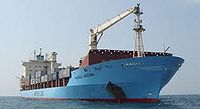Vessel Feeders
Vessel feeder is a vessel which is part of a cargo network in which the larger, faster vessels only call at the major ports at both ends of the area being covered, and the smaller ports are served by the smaller feeder vessels which transfer the cargo to and from the major port terminals and thus keep the larger vessels filled closer to capacity and spare them the expense and loss of time in loading and unloading in the subsidiary ports.
Feeder vessels or feeder ships are ships of various sizes, but mostly understood to be seagoing vessels with an average capacity of carrying 300 twenty-foot equivalent units (TEU) to 500 TEU. Feeders collect shipping containers from different ports and transport them to central container terminals where they are loaded to bigger vessels. In that way the smaller vessels feed the big liners, which carry thousands of containers. Over the years, feeder lines have been established by organizations transporting containers over a predefined route on a regular basis. Feeder ships are often run by companies that also specialize in short sea shipping. These companies not only ship freight to and from ports like Rotterdam for further longhaul shipment, but also carry containers between smaller ports, for example, between terminals located on the north-west European seaboard and ports situated on the Baltic Sea coastline.
While container shipping is currently uncommon on the Great Lakes, a proposal for shipping containers from the port of Oswego on Lake Ontario in upstate New York down the Saint Lawrence Seaway for transfer to larger ocean-going ships at Melford International Terminal in Nova Scotia is currently (2008) being considered.
Video
